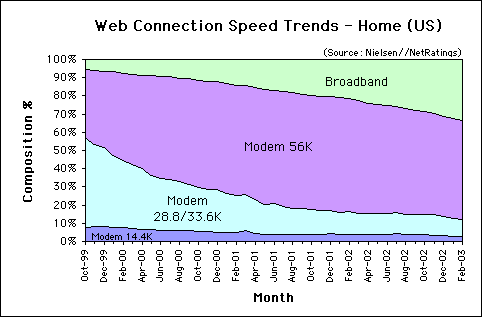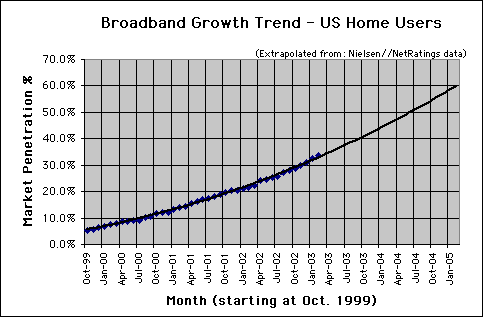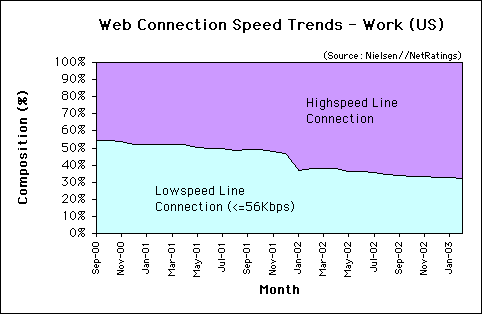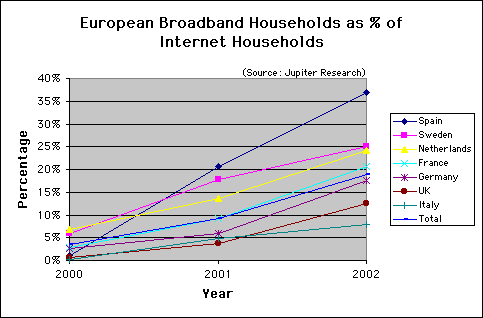How fast are most connection speeds in the US and Europe? In this month’s Bandwidth Report we review European broadband penetration trends and find Spain ahead of all countries surveyed.
The following charts, derived from Nielsen//NetRatings and Jupitermedia data, show trends in connection speeds to the Internet.
Home Connectivity
As of February 2003, most users connect to the Internet using dial-up modems of 56Kbps or less. 54.2% use 56Kbps modems, 9.7% use 28/33.3Kbps, and 2.6% use 14.4Kbps modems. All told 66.5% of home users in the US connect to the Internet at 56Kbps or less (see Figure 1).
Web Connection Speed Trends – Home Users (US)
Figure 1: Web Connection Speed Trends – Home Users (US)
Source: Nielsen//NetRatings
Broadband Penetration
Broadband use in US homes continued along its steady growth curve in February. As of February of 2003 broadband penetration was at 33.5%, up from 32.6% in January.
Extrapolating the data provided by Nielsen//NetRatings, broadband share in the US should exceed 50% by June of 2004 (see Figure 2).
Broadband Connection Speed Trend – Home Users (US)
Figure 2: Broadband Connection Speed Trend – Home Users (US)
Extrapolated from Nielsen//NetRatings data
Work Connectivity
Most workers in the US enjoy high-speed connections to the Internet. Most use a high-speed line such as a T1 connection, and share bandwidth between computers connected to a network. The speed of each connection decreases as more employees hook up to the LAN. As of February of 2003, of those connected to the Internet, 67.9% of US users at work enjoy a high-speed connection. 32.1% connect from work at 56Kbps or less (see Figure 3).
Web Connection Speed Trends – Work Users (US)
Figure 3: Web Connection Speed Trends – Work Users (US)
Source: Nielsen//NetRatings
European Connectivity
In most European countries broadband penetration has trailed the US, with one notable exception. Spain tops European countries with 37% of wired users on broadband, and the highest growth rate. Swedish surfers (the wired kind) came in second to Spain with 25% on broadband. The Netherlands (24%), France (21%), and Germany (18%) follow close to Sweden. Of the European countries surveyed by Jupiter Research, the UK (13%) and Italy (8%) have the lowest penetration of broadband users connected to the Internet. Overall 19% of European users had broadband by the end of 2002 (see Figure 4).
In terms of raw number of users Germany leads European countries with 2,847,669 broadband users. France and the UK follow with 1,520,257 and 1,231,878 high-bandwidth users respectively.
European Broadband Trends
Figure 4: European Broadband Trends
Source: Jupiter Research
Broadband Households as % of Internet Households
| By Country | 2000 | 2001 | 2002 |
|---|---|---|---|
| Spain | 1% | 21% | 37% |
| Sweden | 6% | 18% | 25% |
| Netherlands | 7% | 14% | 24% |
| France | 3% | 9% | 21% |
| Germany | 3% | 6% | 18% |
| UK | 1% | 4% | 13% |
| Italy | 0% | 5% | 8% |
| Europe Total | 3% | 9% | 19% |
European Broadband Households (thousands)
| By Country | 2000 | 2001 | 2002 |
|---|---|---|---|
| Spain | 15 | 417 | 1,048 |
| Sweden | 129 | 429 | 656 |
| Netherlands | 190 | 504 | 925 |
| France | 128 | 546 | 1,520 |
| Germany | 284 | 834 | 2,848 |
| UK | 48 | 312 | 1,232 |
| Italy | 9 | 230 | 493 |
| Europe Total | 1,309 | 4,555 | 11,194 |




